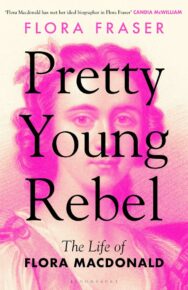‘I do hope readers will enjoy Pretty Young Rebel. I hope they will also come away with the sense, that this was a woman who was admired and respected by all but at the same time was scrambling to negotiate the dangers and vagaries of life on two continents with few resources as best as she could.’
Bonnie Prince Charlie’s escape from Scotland with the help of Flora Macdonald is one of Scotland’s most iconic stories. Flora Fraser, in her biography of the young heroine, finds a woman that experienced so much more in her life. We speak to her about her latest book.
Pretty Young Rebel: The Life of Flora Macdonald
By Flora Fraser
Published by Bloomsbury
Can you tell us a little bit of what we can expect from Pretty Young Rebel?
Flora’s story could well be told as a historical novel. Her life is so packed with romantic and dramatic incident. But I am a historical biographer, and so the book is based on documents in the Royal Archives, in the National Library of Scotland, in the British and National Libraries, in the US Library of Congress, and in other repositories.
For those unfamiliar, who is Flora Macdonald, and why is her story so significant?
Flora belonged to the Macdonalds of Clanranald, and grew up on a tack, or farm, adjacent to the residence of the head of the clan and his wife, ‘Lady Clan’ on Benbecula in the Western Isles. While the Clanranalds were Catholic, Flora’s maternal grandfather was known as ‘the Strong Minister’, and Flora was all her life a staunch Presbyterian.
As a young gentlewoman on the Long Island, as the Western Isles were then known, Flora was a key player in the 1746 escape of Bonnie Prince Charlie from Redcoats, or Hanoverian army officers and men, from the Uists to Skye. Following which, she is taken prisoner and sent to London for trial.
Returning to Skye as a Jacobite heroine, she lives quietly with her husband and seven children for a time. But economic distress impels them in the 1770s to emigrate to the British colony of North Carolina, where she is immediately swept up in the American Revolution.
The family takes the fatal decision to stay loyal to the Crown, and Flora’s husband is taken prisoner. Flora, in her early fifties and in poor health, spends years at the plantation they bought, destitute and in fear of her life from robbers, before her son-in-law, another loyalist officer, rescues her.
A period in Nova Scotia with her husband., discharged from prison and now in a loyalist Highland Emigrant regiment, is succeeded by final years back in Skye. Astonishingly Flora manages to secure a Royal pension from the future Hanoverian King, George IV which, with financial aid from a successful officer son in Sumatra, eases her distress.
Her funeral on Skye, when she dies in 1790 at the age of 68, is attended by thousands and is a sign of the respect which she elicited all her life.
Flora’s story resonates to this day in Scotland and further afield, because she was no keen Jacobite rebel, unlike other Scotswomen, who urged on their clans into battle. She was reluctant to be involved in the 1746 escape plan and have the Prince accompany her, dressed as her ‘Irish maid’, over the Minch to Skye. She rightly feared for her ‘character’ or virginal reputation, all important then for a young woman contemplating future matrimony. She yielded, because, as she told a Hanoverian captor, ‘I would have done the same for you, had you been in distress.’ This remark circulates in the highest circles in London. Her courage in accompanying ‘Betty Burke’, alias Prince Charles Edward, on the stormy midnight voyage is commemorating in the son, ‘Speed, bonny boat, like a bird on the wing/O’er the sea to Skye’.
Flora’s character and strong moral sense attracted too the interest of Dr Johnson and his companion, James Boswell, when they were on their 1773 Highland Tour. Johnson paid a famous tribute to Flora in his account of his travels which is inscribed on her grave in Skye. Boswell later published a lengthy narrative of the Prince’s escape taken from Flora as well as from other 1746 conspirators. As she told the Edinburgh lawyer, however, she had already given a full account of the escape in the later 1740s to an enterprising Jacobite cleric in Leith. This was later to be published, with the accounts of other conspirators, in the late nineteenth century as ‘The Lyon in Mourning’.
Flora’s adherence, with the other members of her family, to the Crown in the American Revolution , when they were living in North Carolina, was a function of their recent arrival in the colonies and also of their earlier experience of the Crown’s power in crushing the 1745 Rising. They could not believe that the ramshackle patriot militia they saw could defeat the British forces. Those Scots who had been in residence in America for decades, knew better the political fire that animated these patriots and were more likely to support the revolutionaries.
What drew you to tell her story?
I grew up between London and Inverness-shire and was named after Flora Macdonald, then very much a local heroine in the latter place. Her statue stands outside Inverness Castle, and as a child I was always interested in her story as the ‘Prince’s Protector’. But I never thought of writing her biography, until I was searching for illustrations for my last book, The Washingtons: George & Martha. And I came across her portrait by Allan Ramsay from the 1740s among a sheaf of images s of American revolutionaries from the 1770s. Then I remembered that in 1773 she effectively told Dr Johnson that he was lucky to catch her as she was off to America.
The process of researching someone’s life and condensing it into the key moments feels a vast task. How do you approach this? What are the most enjoyable or interesting parts of this process for you?
I have always loved doing primary research especially in archives and uniting all the papers from multiple archives in one chronological stream. But I used to dread taking all my research and weaving the salient facts into a narrative. I’ve finally – after forty-odd years of writing historical biography! – learnt to embrace a period of constructive chaos, as I term it. And I swim or go for walks or go and read – fiction unrelated related to the book in question – in a library. Or even go to the cinema alone in the daytime – wicked pleasure! – or do any activity where I’m sure not to have the company or conversation of others. And thoughts arise … And after a time, the arc of the book is clear. And I can start writing. Which I love, even though it can be like being at the coalface sometimes for weeks or even months. I think it helps enormously to know that I have been in every one of these stages of anguish and even torture before. And a book has always emerged.
Though many would likely be most familiar with Flora’s part in Bonnie Prince Charlie’s escape, what are some of your favourite lesser-known anecdotes or stories from her life?
My favourite anecdote? When Bonnie Prince Charlie was dressing on the shore on the Long Island as ‘Betty Burke’, Flora’s Irish maid, for the midnight voyage to Skye, he wanted to carry his pistols under his petticoats. Flora refused to allow it.
‘Indeed, Miss,’ the prince replied, ‘if we shall happen to meet with any that will go so narrowly to work in searching as what you mean, they will certainly discover me [his male sex] at any rate.’ For all the jocularity, Flora prevailed, and Charles Edward boarded the boat without the firearm under his skirts.
You’ve written multiple books on women from history; do you find yourself consciously drawn to women in history whose wider stories are perhaps lesser known compared to others’?
I come across the voices – in letters or in diaries etc -of certain women in the eighteenth century and to me they stick up like stalagmites from the ordinary run of eighteenth-century women. This was true of Emma , Lady Hamilton, of George IV’s Queen Caroline, of the six daughters of George III, of Pauline Bonaparte, Prince Borghese, and of Martha Washington. |And I want to worry away at them like a dog a bone until I have their story to share with others. I suppose I am interested in lesser-known women because there are generally excellent biographies already of better-known women. But in all my biographies there have been major male figures in the book too. Nelson; George IV; George III; Napoleon; George Washington. Flora is the first historical character whom I have considered who is without a male counterpart on whom to lean. As you will see in the book neither the Prince not her husband was – what shall we say – reliable?
Are there any people from history you’ve yet to write about who you think have fascinating stories and you’d perhaps like to do a project on some day? What is it about them that interests you?
I have been fascinated by Horatio Nelson since I was a child. He was our greatest ever naval commander and sure of himself at sea from an early age. On shore he was loved as no other officer was by the public, and won a unique place too, in the hearts of many far superior to him in education and rank. His insecurities were understood and calmed by his lover, Emma, and by his family, if not by the wife he mis-treated. So, my next project, on which I am just embarking, for Bloomsbury, my publishers, is Nelson: At Shore and At Sea.
What do you hope readers take from Flora’s story and Pretty Young Rebel?
I do hope readers will enjoy Pretty Young Rebel. I hope they will also come away with the sense, that this was a woman who was admired and respected by all but at the same time was scrambling to negotiate the dangers and vagaries of life on two continents with few resources as best as she could.
Pretty Young Rebel: The Life of Flora Macdonald by Flora Fraser is published by Bloomsbury, priced £25.
ALSO IN THIS ISSUE

 Pretty Young Rebel: A Q & A with Flora Fraser
Pretty Young Rebel: A Q & A with Flora Fraser
‘I do hope readers will enjoy Pretty Young Rebel. I hope they will also come away with the sense, th …

 Peak Beyond Peak
Peak Beyond Peak
‘If a traveller is on the right line they will find the trail blazed for them at every cross-road.’













